Cladding enhances a building's exterior by providing a durable, weather-resistant layer that adds aesthetic appeal and insulation, while paving is primarily used for creating functional, stable surfaces such as driveways, walkways, and patios. Stone cladding offers a sleek, modern finish or rustic charm depending on the stone type, whereas stone paving emphasizes texture and slip resistance to ensure safety and longevity. Both utilize natural stone's strength but serve distinctly different architectural and landscaping purposes.
Table of Comparison
| Feature | Cladding | Paving |
|---|---|---|
| Purpose | Exterior wall protection and aesthetic enhancement | Surface covering for walkways, patios, and driveways |
| Material Types | Natural stone, slate, granite, marble | Granite, sandstone, limestone, concrete stone |
| Installation | Vertical application on walls, requires adhesive or mechanical fixings | Horizontal application on ground, requires base preparation and compaction |
| Durability | Weather-resistant, protects structure from moisture and damage | High load-bearing capacity, resistant to wear and weather |
| Maintenance | Periodic cleaning and sealing to maintain appearance | Regular cleaning and occasional re-leveling or joint replacement |
| Cost | Moderate to high, depends on stone type and installation complexity | Generally lower, varies with stone choice and surface area |
| Aesthetic Impact | Enhances building facade with texture and color | Defines outdoor spaces with patterns and natural stone beauty |
Understanding Stone Cladding and Paving
Stone cladding involves attaching thin stone veneers to walls, enhancing aesthetic appeal and providing weather protection, while stone paving consists of laying flat stone pieces on ground surfaces for durability and traction. Cladding materials vary from natural stone types like granite, limestone, or slate, selected for texture and color, whereas paving stones emphasize strength and slip resistance, commonly using granite or sandstone. Understanding the differences in installation, maintenance, and functional properties helps optimize the choice between stone cladding and paving for architectural and landscaping projects.
Key Differences Between Cladding and Paving
Cladding involves applying stone panels to vertical surfaces, enhancing building aesthetics and providing weather protection, while paving refers to laying stone slabs on horizontal surfaces for walkways, driveways, or patios. The primary difference lies in their functional applications: cladding improves facade durability and insulation, whereas paving offers a sturdy, slip-resistant ground covering. Stone thickness, installation techniques, and load-bearing requirements also vary significantly between cladding and paving projects.
Advantages of Stone Cladding
Stone cladding enhances building aesthetics by providing a natural, elegant appearance with diverse textures and colors. It offers superior durability and weather resistance, protecting structures from moisture, temperature fluctuations, and external damage. Lightweight compared to full stone walls, stone cladding also improves insulation, contributing to energy efficiency in both residential and commercial applications.
Benefits of Stone Paving
Stone paving offers exceptional durability and weather resistance, making it ideal for high-traffic outdoor areas. Its natural texture provides excellent slip resistance, enhancing safety around pools and walkways. The aesthetic versatility of stone paving allows for custom patterns and finishes that increase property value and curb appeal.
Aesthetic Appeal: Cladding vs Paving
Cladding enhances aesthetic appeal by providing textured, multi-dimensional surfaces that add depth and character to building exteriors, using natural or engineered stone materials. Paving offers a more uniform and practical look, emphasizing smooth, durable surfaces ideal for functional outdoor areas like patios and walkways. Stone cladding typically allows for greater visual variation and artistic expression compared to the consistent patterns found in stone paving.
Durability and Maintenance Comparison
Stone cladding offers superior durability by providing a resistant protective layer against weathering and impacts, reducing the need for frequent repairs compared to paving stones which may crack under heavy loads. Maintenance of stone cladding is generally lower since it resists staining and erosion better than paving surfaces that require periodic sealing and weed control. Choosing stone cladding enhances structural longevity and minimizes upkeep, while paving demands ongoing maintenance to preserve functionality and appearance.
Installation Processes for Cladding and Paving
Installation of stone cladding involves securing thin stone panels or veneers onto structural walls using adhesives, mechanical fasteners, or metal frameworks, ensuring precise alignment and structural integrity. Paving installation requires preparing a stable base with compacted subsoil and a bedding layer of sand or mortar, followed by carefully laying stone slabs or blocks in desired patterns, then filling joints with sand or grout for stability. Proper surface preparation and moisture control are critical in both processes to enhance durability and prevent issues like shifting or detachment.
Cost Considerations: Cladding vs Paving
Cladding typically incurs higher upfront costs due to material quality and specialized installation techniques compared to paving, which generally uses more affordable materials like concrete or asphalt. Maintenance expenses for cladding can be lower over time as stone panels resist weathering better than many paving surfaces, which may require frequent repairs or resurfacing. Budget decisions should factor in both the initial investment and long-term durability to determine the most cost-effective stone application.
Best Applications for Stone Cladding
Stone cladding is best suited for exterior and interior walls, providing an aesthetically pleasing, durable surface that enhances architectural appeal while offering excellent weather resistance. Its natural insulation properties make it ideal for thermal regulation in building facades. Unlike paving, which is designed for horizontal surfaces subjected to heavy foot traffic, stone cladding excels in vertical applications where its strength, texture, and decorative qualities can be fully utilized.
Ideal Uses for Stone Paving
Stone paving is ideal for creating durable and visually appealing outdoor surfaces such as patios, walkways, and driveways, where strength and weather resistance are crucial. Its natural textures and colors enhance landscape aesthetics while providing excellent slip resistance and low maintenance requirements. Stone paving withstands heavy foot traffic and vehicle loads, making it a practical choice for both residential and commercial exterior spaces.
Cladding vs Paving Infographic

 materialdif.com
materialdif.com